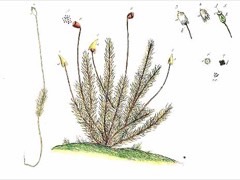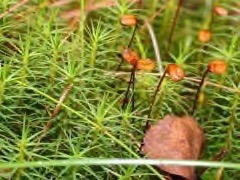 |
|
edibleplants.org |
 |
| Kristian Peters - Fabelfroh wikimedia.org |
Translate this page:
Summary
Physical Characteristics

 Polytrichum commune is an evergreen Perennial growing to 0.2 m (0ft 8in) by 0.3 m (1ft) at a slow rate.
Polytrichum commune is an evergreen Perennial growing to 0.2 m (0ft 8in) by 0.3 m (1ft) at a slow rate.
See above for USDA hardiness. It is hardy to UK zone 3. The flowers are pollinated by Wind.
Suitable for: light (sandy), medium (loamy) and heavy (clay) soils and can grow in nutritionally poor soil. Suitable pH: mildly acid soils and can grow in very acid soils.
It can grow in full shade (deep woodland) semi-shade (light woodland) or no shade. It prefers moist or wet soil.
UK Hardiness Map
US Hardiness Map
Synonyms
P. assimile Hampe P. brachypelma Müll. Hal. P. cataractarum Müll. Hal. P. commune var. commune P. commune var. uliginosum Wallr. P. elatum P. Beauv. P. leonii Papp P. madagassum Hampe P. mildbraedii Broth. P. paludicola Cardot P. purpurascens Brid. P. quadrangulare Gilib. P. radulifolium Müll. Hal. P. remotifolium P. Beauv. P. subformosum var. anomalum Thér
Plant Habitats
Edible Uses
References More on Edible Uses
Medicinal Uses
Plants For A Future can not take any responsibility for any adverse effects from the use of plants. Always seek advice from a professional before using a plant medicinally.
Used by some people to make a tea to dissolve kidney and gall bladder stones (borealforest.org).
References More on Medicinal Uses
The Bookshop: Edible Plant Books
Our Latest books on Perennial Plants For Food Forests and Permaculture Gardens in paperback or digital formats.

Edible Tropical Plants
Food Forest Plants for Hotter Conditions: 250+ Plants For Tropical Food Forests & Permaculture Gardens.
More

Edible Temperate Plants
Plants for Your Food Forest: 500 Plants for Temperate Food Forests & Permaculture Gardens.
More

More Books
PFAF have eight books available in paperback and digital formats. Browse the shop for more information.
Shop Now
Other Uses
A low to medium density groundcover with a mat forming habit. An Ornamental for shady, damp areas. It is used by some people to make a tea to dissolve kidney and gall bladder stones (borealforest.org). Good for hair, Made into a tea to rinse to strengthen hair. Stems have been woven and used to make baskets (tolweb.org).
Special Uses
References More on Other Uses
Cultivation details
Prefers lightly shaded areas with moist slightly acidic soil, it can also survive in areas of full sunlight provided the soil is moist. Can also grow in areas of poor soil and slow drainage. For polyculture design as well as the above-ground architecture (form - tree, shrub etc. and size shown above) information on the habit and root pattern is also useful and given here if available. A clumping mat former. Forming a dense prostrate carpet spreading indefinitely [1-2].
References Carbon Farming Information and Carbon Sequestration Information
Temperature Converter
Type a value in the Celsius field to convert the value to Fahrenheit:
Fahrenheit:
The PFAF Bookshop
Plants For A Future have a number of books available in paperback and digital form. Book titles include Edible Plants, Edible Perennials, Edible Trees,Edible Shrubs, Woodland Gardening, and Temperate Food Forest Plants. Our new book is Food Forest Plants For Hotter Conditions (Tropical and Sub-Tropical).
Shop Now
Plant Propagation
Spores. During the summer spores are released and carried by the wind.
Other Names
If available other names are mentioned here
Common haircap, great golden maidenhair, great goldilocks, common haircap moss, common hair moss
Native Range
Coming Soon
Weed Potential
Right plant wrong place. We are currently updating this section.
Please note that a plant may be invasive in one area but may not in your area so it's worth checking.
None Known
Conservation Status
IUCN Red List of Threatened Plants Status : Not Listed.

Growth: S = slow M = medium F = fast. Soil: L = light (sandy) M = medium H = heavy (clay). pH: A = acid N = neutral B = basic (alkaline). Shade: F = full shade S = semi-shade N = no shade. Moisture: D = dry M = Moist We = wet Wa = water.
Now available:
Food Forest Plants for Mediterranean Conditions
350+ Perennial Plants For Mediterranean and Drier Food Forests and Permaculture Gardens.
[Paperback and eBook]
This is the third in Plants For A Future's series of plant guides for food forests tailored to
specific climate zones. Following volumes on temperate and tropical ecosystems, this book focuses
on species suited to Mediterranean conditions—regions with hot, dry summers and cool, wet winters,
often facing the added challenge of climate change.
Read More
Expert comment
Author
Hedw.
Botanical References
Links / References
For a list of references used on this page please go here
Readers comment
| Add a comment |
|
If you have important information about this plant that may help other users please add a comment or link below. Only comments or links that are felt to be directly relevant to a plant will be included. If you think a comment/link or information contained on this page is inaccurate or misleading we would welcome your feedback at [email protected]. If you have questions about a plant please use the Forum on this website as we do not have the resources to answer questions ourselves.
* Please note: the comments by website users are not necessarily those held by PFAF and may give misleading or inaccurate information.
To leave a comment please Register or login here All comments need to be approved so will not appear immediately.
|
Subject : Polytrichum commune
|
|
|
|